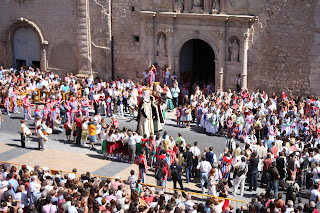BERCA, dance group established in Algemesí (València, Spain) at 1981, on the initiative of Pepe Castell, "el Pero", with his wife Laura Castell ,"l'Oliera", and Yolanda Pellicer, "la Tirana", following their separation from Pardines group that had been created the previous year 1980. That Pardines group had emerged sheltered from the current dance called "les Llauradores"- exactly a Bolero dancing as it was known-, which was incorporated in the procession of the Mare de Déu de la Salut in 1934, whose dancers were the only surviving witnesses of the ancient existing "group" in Algemesí at least since the late nineteenth century. Following the creation of the new group, Berca, was immediately added algemesinenses others interested in singing, dancing and clothing about Valencian folk traditions in general, but without a strong emphasis on local folk manifestacions. That is why, since 2003 until now, Berca undertaken the research and recovery or restoration of local folk elements different from those that have demonstration in Algemesí every September 7th & 8th in the processions of the Festa a la Mare de Déu de la Salut (Feast of Our Lady of Health, declared Intangible Heritage of Humanity by UNESCO in 2011), as well as Cabuts / Cabezudos with their two dances, the Giants Jaume I and Violant I of Hungary (first king and queen of Kingdom of Valencia) and their dance -reinstated in the Festa in 2007-; Carols Round every December 26th and, especially, the traditional “les Danses” or street dance of Algemesí, which the last edition in 2013 featured more than 400 participants. Organizes and conducts Masquerade Carnival, together with the Municipal School of Tabalet and Dolçaina of Algemesí and the grouping of Trabukatu, with its batucada. Besides all this, has been restored and extended the ancient Bolero Vell, source or origin of the current and dismembered processional boleros that are currently danced in the Festa a la Mare de Déu de la Salut; also, the Jota "la Cebera" and the Valencianes. Berca is a legally constituted association, being a free entity and nonprofit, open to anyone interested in participating in its aims. Since 1990, is Director or Mestre of Berca Grup de Danses d’Algemesí the member Vicent J. Vidal Esteve, "el Menescal", a member of the group since 1985.
BERCA, rural area of the municipality of the ancient University and current City of Algemesí, formerly also called as Massaseli, and where in 1247 was discovered the sculpture of the Mare de Déu de la Salut into the hollow trunk of a mulberry tree by a farmer, right in the place where is the Hermitage of Find, as is called that chapel.
BERCA, stuck walking path along the Rambla of Algemesí, Seco river or river Magro, heading to his named rural area and that starts at the Alzira bridge at the Ancient Royal Road of Valencia.
BERCA, old street of the town, which starts in the little Plaça del Carbó and ending in the Hermitage where the Mare de Déu de la Salut was found. Formerly, this street was heading to the rural area refered. It's all scene of the Processoneta del Matí of September 8th in the Festa a la Mare de Déu de la Salut, in other time also called as Mare de Déu de Berca. On the street, there's the Well of Berca or the Well of the Virgin, in the place where the roots of mulberry were found. Hence it’s also popularly known as Well's Street.
BERCA, from the Arabic word Birkin, that means laundry, raft or water tank. Name given to the place of the rural area referred, now partly included in the urban core, because of the probable existence of those wrapper construction of water, vital for irrigation, livestock or serving households.
Therefore, the aqueous image and humid environment chosen to illustrate our blog: raindrops, in remembrance of the origin of the primitive word BERCA in Algemesí.




